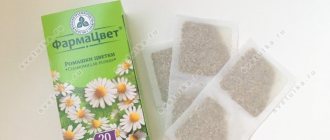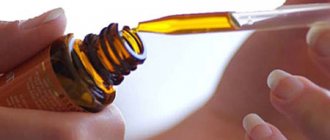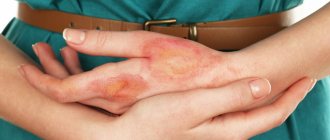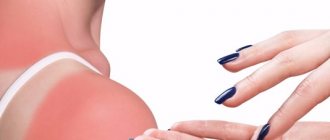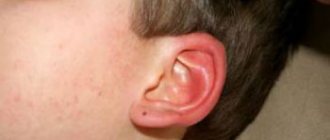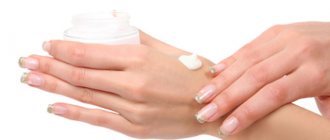Why does iodine burn occur?
Surprisingly, the causes of iodine burns on the skin are quite common. A burn from iodine on the body or face can be caused by the following actions:
- when handling the substance incorrectly,
- due to non-compliance with the rules for storing the substance,
- due to violation of safety regulations when handling any chemical substances.
But these are general reasons, and individually such an injury can be caused under the following circumstances:
- due to an attempt to process mucous bodies,
- with intensive treatment of the skin,
- with internal use of iodine (to obtain mineral iodine),
- due to rinsing the mouth with an excessive concentration of iodine solution.
In addition, you need to know: in certain individuals, the alcohol form of iodine, upon contact with the skin and mucous membranes of the body, leads to the manifestation of unpleasant allergic reactions, which are expressed not only in allergic rashes, but also cause serious burns.
Causes of injury
Iodine solution is characterized by the presence of anti-inflammatory and disinfectant properties, which is why it is widely used in medical practice. However, like any other alcohol-containing product, if used ineptly or carelessly, it can cause a chemical burn.
You can get burned if basic safety rules are not followed, as well as if the product storage rules are violated. An iodine burn can occur if you intensively smear the product on damaged skin, mucous membranes, or use the solution for rinsing the mouth or taking it orally.
Often this injury occurs in small children, so the product must be stored in a place inaccessible to children.
In some people, iodine, due to individual characteristics, causes the development of allergic reactions, even burns, even if the wound is smeared according to all the rules. Therefore, before using this drug, it is recommended to conduct a preliminary test by applying it to a small area of the skin.
The susceptibility to this type of damage increases in patients with a weakened immune system who have recently suffered viral or infectious diseases, which is due to excessive sensitivity and susceptibility to iodine of the thyroid gland. The skin on the face is considered the most sensitive, so it is the facial area that suffers especially often when disinfected with iodine.
Symptoms
After skin traumatization with iodine, unpleasant symptoms in the victim usually appear only after a while. The signs of an iodine burn are similar to the symptoms of chemical exposure to the epidermis, but they also have their own characteristics.
The main manifestations indicating that the skin is burned by iodine are:
- the appearance of a dark spot on the treated area,
- if the mucous membranes are damaged, their deformation and discoloration are noted,
- peeling of the skin at the site of contact with the substance, because iodine is a drying substance,
- Iodine that gets into the eyes provokes burning, lacrimation, and redness of the whites of the eyes.
With short-term exposure to the substance, these signs are not observed for long and often disappear completely within 2-3 days. But with longer contact with iodine, the situation can only get worse and in order to remove the consequences of the harmful interaction and get rid of the iodine burn, you will need to contact a specialist.
Consequences
Typically, an iodine solution does not cause serious damage. Redness, allergic manifestations, and a dark spot may persist at the burn site. Recovery is more difficult in patients with damage to the mucous membranes and eyes.
The greatest danger comes from oral consumption of the pure product. In this case, the lethal dose is about 3 g of the substance.
Even if a smaller amount of medicine is drunk, patients experience serious disturbances in the functioning of the kidneys, digestive, respiratory, and cardiovascular systems.
Iodine burns occur quite often in everyday life. Usually it does not cause significant harm to health. To prevent negative consequences when using the product, you should carefully follow the recommendations specified in the annotation.
If first aid is provided correctly, a chemical burn to the skin will not cause any serious consequences. After healing, a dark spot may remain at the wound site, but with proper treatment it will go away. When the mucous membranes are damaged, redness remains at the burn site for several days.
First aid
Since an iodine burn is a chemical injury, first aid will be the same as for a chemical burn. The victim needs to be provided with qualified first aid as quickly as possible, since the effectiveness of subsequent treatment and how quickly a burn from iodine can be cured often depends on it. But it also happens that after quality premedical care, the victim no longer needs further therapy.
What should you do immediately after getting a burn from iodine?
First, you should rinse the damaged area with copious amounts of cold water - you can place the problem area under a stream of water. If the oral cavity burns with iodine, then you need to gargle it and your throat for 10-15 minutes. What to do if an eye burn occurs? In such circumstances, immediately wash the mucous membrane with cool water. For this purpose, they fill a basin with water, lower their face into it, and then blink their eyes under the water.
In addition, you can try to neutralize a burn with iodine on the skin. But how to apply iodine burns in this case? Often the neutralizer is toothpaste or powder, chalk, soap or sugar solution. They are applied directly to the affected area of the skin. If a person has a burn in the oral cavity, then rinse the mouth and throat with neutralizing agents.
As for the mucous membrane of the eyes, neutralization of the chemical substance is possible only in a hospital setting. If severe damage is observed or children or elderly people have been burned, then you should not use the Internet to find out how to further treat a burn from iodine. You need to seek medical help as soon as possible to minimize possible complications.
What is strictly forbidden to do
In the event of a burn from iodine, it is highly undesirable to perform the following actions:
- It is forbidden to lubricate iodine burns with manganese solution,
- Do not apply ice to reduce pain,
- If blisters form, it is not recommended to pierce them,
- Treatment of the affected area with alcohol solutions should be avoided.
Clinical manifestations
An iodine burn can be of the first or second degree of severity. Often clinical signs appear some time after the injury. Experts identify the following symptoms that occur in a victim of an iodine burn:
- Skin burn – the appearance of specific dark spots on the skin;
- Deformation of the mucous membranes, darkening and swelling - when applying the product to the mucous membranes;
- Peeling;
- Painful sensations;
- Skin itching and burning.
An iodine burn to the eyes is accompanied by lacrimation, burning, and redness. If the larynx and esophagus are damaged, the victim complains of pain, spasms, difficulty swallowing, and cough syndrome may occur.
Despite the fact that an iodine burn is considered a fairly minor injury, the patient is strongly advised to see a qualified specialist, since this substance can provoke the development of severe allergic reactions, especially if the injury occurs in a child!
First aid measures
First aid consists of washing the damaged area with plenty of water to remove any remaining chemicals and neutralize their effects. In case of injuries to the mouth, throat or larynx, rinse thoroughly with cool water for 20–15 minutes.
For fresh lesions, the washing process should take about 10 minutes, but if the injury was received approximately half an hour ago, then the damaged surface is treated with water for at least 20-30 minutes! The next thing to do is to treat the injured area with a neutralizing substance. For these purposes, soap or sugar solutions and crushed chalk are used.
After this, you need to seek advice from a specialist who can assess the severity of the patient’s condition and tell you how to properly and quickly eliminate the resulting burn.
Treatment of burns from iodine
Many people wonder how to treat an iodine burn on the body or face? In effective treatment of chemical burns, pharmacological drugs are certainly used, which are prescribed by a competent specialist. Of course, the majority will argue that a burn from iodine can be cured using folk recipes, however, as in the case of drug therapy, such treatment must also be previously agreed upon with the attending physician. Indeed, despite the effectiveness of some alternative methods, many of them can only aggravate the situation.
Drug treatment
The following pharmacological agents are often used in traditional treatment of chemical burns:
- antiseptics,
- analgesics,
- decongestants,
- wound healing agents.
Thus, antiseptics counteract secondary infection, which is possible due to trauma to the upper layers of the dermis. Painkillers are used for severe injuries to reduce the intensity of pain. Decongestant medications will be relevant when an allergic reaction develops due to a burn and inflammatory processes are observed. As for wound healing agents (ointments, creams), they are indispensable for restoring the epidermis. Iodine burn ointment is especially indispensable when large areas of the skin are damaged.
It is often possible to quickly get rid of an iodine burn if you use complex drugs such as Panthenol or Olazol. They are available in any pharmacies in the form of sprays. Thus, such medications immediately have an analgesic, decongestant, antibacterial and regenerating effect. Often, doctors also prescribe ointments such as Bepanten, Rescuer or Chlorhexidine to their patients.
Treatment with folk remedies
For minor iodine burns, you can resort to alternative medicine. As a rule, the most often used are:
- toothpaste,
- sea buckthorn oil,
- oatmeal porridge,
- grated potatoes,
- beaten egg white,
- brewing black or green tea.
It has already been mentioned that toothpaste is used as an iodine neutralizer in first aid. In the future, it helps relieve pain and promotes rapid healing. To do this, it must be applied every 4-5 hours. Hercules porridge also speeds up healing. For this purpose, a pre-chilled product is applied to the affected area. In addition, you can apply compresses with grated potatoes to the wound (for 15 minutes) or lubricate problem areas with pre-whipped egg whites (the procedure is repeated every 2 hours).
In addition, strong tea leaves have excellent pain-relieving, regenerating and anti-inflammatory properties. The bandage is soaked in the tea leaves cooled to room temperature, after which it is applied to the affected area for a quarter of an hour.
Also, do not forget about sea buckthorn oil, especially as a remedy that helps remove iodine burns on the face. Therapy with this product comes down to systematic treatment of the damaged area of skin for 3 days. However, do not forget that it is still undesirable to apply any oily products immediately after a burn.
Prevention
Avoiding burns with iodine is quite simple - you need to use it carefully.
- When burning acne, you do not need to apply a large amount of the substance.
- Wounds should be treated carefully, avoiding contact with damaged surfaces.
- Apply the medicine to the skin with a cotton swab, a small amount.
The iodine burn goes away quite quickly. However, if suspicious symptoms appear, the inflammatory process spreads, or the wound becomes suppurated, you should contact a medical facility as quickly as possible.
How long does it take
Another important point that concerns victims is the question of how long does a burn from iodine last? But no specialist can give a specific figure. How long a burn from iodine lasts and whether this dark spot will go away at all directly depends on the individual characteristics of the victim’s body, the reproductive abilities of his cells and the degree of tissue damage. In a situation where the rashes on the face were unsuccessfully burned, the burns may go away after a few days. If the mucous membranes or deep layers of the dermis were affected, then the regeneration process can be very long: from several months to up to a year.

